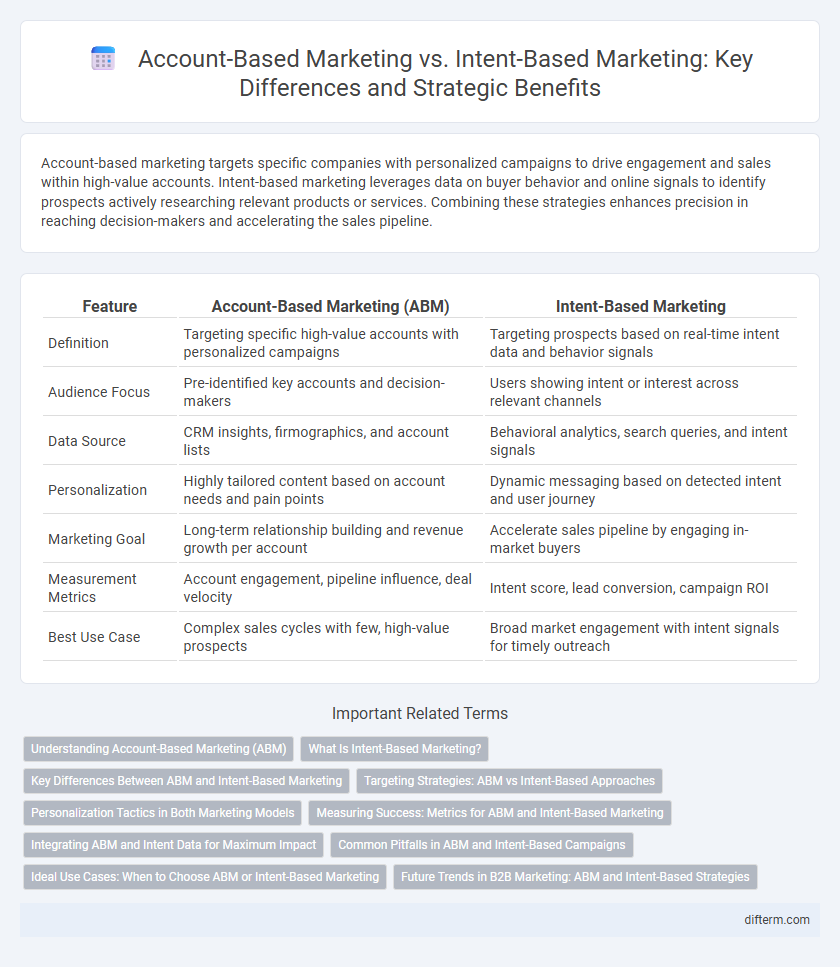Account-based marketing targets specific companies with personalized campaigns to drive engagement and sales within high-value accounts. Intent-based marketing leverages data on buyer behavior and online signals to identify prospects actively researching relevant products or services. Combining these strategies enhances precision in reaching decision-makers and accelerating the sales pipeline.
Table of Comparison
| Feature | Account-Based Marketing (ABM) | Intent-Based Marketing |
|---|---|---|
| Definition | Targeting specific high-value accounts with personalized campaigns | Targeting prospects based on real-time intent data and behavior signals |
| Audience Focus | Pre-identified key accounts and decision-makers | Users showing intent or interest across relevant channels |
| Data Source | CRM insights, firmographics, and account lists | Behavioral analytics, search queries, and intent signals |
| Personalization | Highly tailored content based on account needs and pain points | Dynamic messaging based on detected intent and user journey |
| Marketing Goal | Long-term relationship building and revenue growth per account | Accelerate sales pipeline by engaging in-market buyers |
| Measurement Metrics | Account engagement, pipeline influence, deal velocity | Intent score, lead conversion, campaign ROI |
| Best Use Case | Complex sales cycles with few, high-value prospects | Broad market engagement with intent signals for timely outreach |
Understanding Account-Based Marketing (ABM)
Account-Based Marketing (ABM) targets high-value accounts with personalized campaigns tailored to specific business needs, enhancing engagement and ROI. ABM leverages detailed account insights and cross-channel strategies to align sales and marketing efforts effectively. This approach prioritizes quality over quantity, focusing resources on key decision-makers within targeted organizations.
What Is Intent-Based Marketing?
Intent-based marketing targets potential customers by analyzing real-time behavioral data and online interactions to identify purchase intent signals. This approach leverages AI-driven insights and predictive analytics to deliver personalized messaging that aligns with the prospect's current needs and interests. By focusing on intent data such as search queries, content consumption, and engagement patterns, intent-based marketing enhances conversion rates and optimizes campaign ROI.
Key Differences Between ABM and Intent-Based Marketing
Account-based marketing (ABM) targets specific high-value accounts with personalized campaigns tailored to individual decision-makers, prioritizing deep relationships and long-term engagement. Intent-based marketing leverages real-time data and behavioral signals to identify prospects showing purchase intent across broader audiences, optimizing timing and relevance of outreach. The key differences lie in ABM's precision targeting versus intent marketing's data-driven prospect detection, shaping distinct strategies for customer acquisition and sales acceleration.
Targeting Strategies: ABM vs Intent-Based Approaches
Account-based marketing (ABM) targets specific high-value accounts through personalized campaigns, leveraging detailed firmographic and behavioral data to engage key decision-makers. Intent-based marketing focuses on identifying prospects showing buying signals by analyzing real-time online behaviors, such as content consumption and search queries, allowing marketers to target active buyers with relevant messaging. Combining ABM's precision targeting with intent-based insights enhances lead qualification and improves conversion rates by aligning marketing efforts with buyer readiness.
Personalization Tactics in Both Marketing Models
Account-based marketing (ABM) leverages hyper-personalization by targeting specific high-value accounts with tailored content and customized campaigns based on firmographic and behavioral data. Intent-based marketing uses real-time intent signals, such as search behavior and content consumption patterns, to deliver personalized messaging that aligns with the prospect's current stage in the buyer's journey. Both models emphasize personalization but differ in scope and data sources, with ABM focusing on account-level customization and intent-based marketing prioritizing individualized engagement driven by intent data.
Measuring Success: Metrics for ABM and Intent-Based Marketing
Measuring success in account-based marketing (ABM) involves tracking key metrics such as account engagement, pipeline velocity, and deal expansion within targeted accounts. Intent-based marketing metrics focus on identifying high-intent signals like search behavior, content consumption, and conversion rates to prioritize leads. Both strategies benefit from integrating CRM and marketing automation tools to accurately attribute revenue and optimize campaign performance.
Integrating ABM and Intent Data for Maximum Impact
Integrating Account-Based Marketing (ABM) with intent-based marketing leverages highly targeted account insights and real-time intent signals to enhance personalization and engagement. Combining intent data with ABM enables marketers to identify in-market accounts, prioritize high-value prospects, and tailor content to specific buyer needs, driving higher conversion rates. This synergy amplifies campaign efficiency by aligning marketing and sales efforts with precise account-level intent, maximizing ROI and accelerating the sales cycle.
Common Pitfalls in ABM and Intent-Based Campaigns
Common pitfalls in Account-Based Marketing include neglecting accurate data segmentation, which leads to targeting irrelevant accounts and wasting resources. Intent-based marketing often struggles with misinterpreting intent signals, resulting in premature or inappropriate outreach that can alienate prospects. Both strategies require continuous data validation and alignment between sales and marketing teams to maximize effectiveness and avoid common execution errors.
Ideal Use Cases: When to Choose ABM or Intent-Based Marketing
Account-based marketing (ABM) excels in targeting high-value accounts with personalized campaigns, making it ideal for B2B companies focusing on long sales cycles and complex decision-making processes. Intent-based marketing leverages real-time intent data to capture prospects showing active buying signals, suitable for businesses aiming to accelerate lead generation and engage warm prospects. Choosing between ABM and intent-based marketing depends on whether the goal is deep account penetration or rapid identification of in-market buyers.
Future Trends in B2B Marketing: ABM and Intent-Based Strategies
Future trends in B2B marketing highlight the integration of account-based marketing (ABM) with intent-based strategies to enhance precision targeting and lead quality. Leveraging AI-driven analytics, marketers can identify high-value accounts exhibiting intent signals, enabling personalized campaigns that accelerate the buyer's journey. This hybrid approach maximizes ROI by aligning marketing efforts with real-time customer behavior and buying stage insights.
Account-based marketing vs intent-based marketing Infographic

 difterm.com
difterm.com